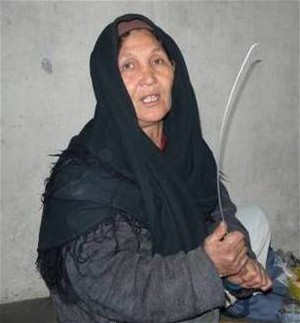Home » Reports & Data » Progress » Transforming Lives » Residents Weave Gabions for Community Projects

A woman in Puli Khumri practices her gabion-weaving skills.
USAID/IDEA-NEW
Teaching gabion-weaving skills and buying gabions from participants contributes to the economy and provides income opportunities for vulnerable members of the community.
7 JUNE 2010 | PULI KHUMRI, AFGHANISTAN
Women and disabled community members in northern Afghanistan face a range of cultural and social barriers when seeking employment. As a result, they are often amongst the poorest members of the community. In collaboration with government line directorates, USAID’s Incentives Driving Economic Alternatives for the North, East, and West (IDEA-NEW) has worked to address this problem by training 423 women and men in gabion weaving in the Puli Khumri District of Baghlan Province. Gabions are key structural components for building protection walls along waterways to prevent flooding and erosion.
Women participating in the project are breadwinners for their families; approximately 100 are also disabled. All 105 men participating in the project are disabled. Teaching these marginalized community members gabion-weaving techniques responds to the growing need for gabions across northern Afghanistan, resulting in sustainable income generation for program participants. Gabions woven in-country are also of higher quality and stronger than those imported from abroad.
According to the Baghlan Department of Women’s Affairs (DOWA), many unemployed women come to request jobs. However, due to a lack of employment opportunities in the province, the DOWA has been unable to meet the women’s needs.
The Baghlan DOWA selected eligible female program participants and located training and workspaces, while IDEA-NEW provided raw materials, trainers, and a 250 Afghani per-day stipend.
As part of the infrastructure component of IDEA-NEW, USAID is implementing nine protection wall projects throughout Puli Khumri District in Baghlan Province. The construction effort will require approximately 13,000 gabions, most of which will be woven by those participating in this project. Each person can complete approximately one six-sided box per day and receives 250 Afghanis (approximately $5).







Comment
Make a general inquiry or suggest an improvement.